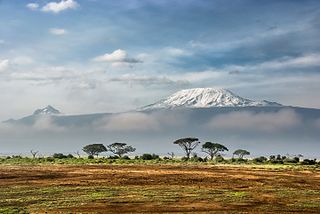
Mount Kilimanjaro is a dormant volcano in Tanzania. It is the highest mountain in Africa and the highest free-standing mountain above sea level in the world: 5,895 m (19,341 ft) above sea level and 4,900 m (16,100 ft) above its plateau base. It is also the highest volcano in the Eastern Hemisphere and the fourth most topographically prominent peak on Earth.
The Seven Summits are the highest mountains on each of the seven traditional continents. On 30 April 1985, Richard Bass became the first climber to reach the summit of all seven.

A picnic is a meal taken outdoors as part of an excursion, especially in scenic surroundings, such as a park, lakeside, or other place affording an interesting view, or else in conjunction with a public event such as preceding an open-air theater performance, and usually in summer or spring. It is different from other meals because it requires free time to leave home.
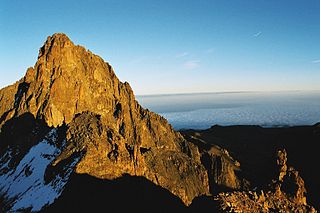
Mount Kenya is an extinct volcano in Kenya and the second-highest peak in Africa, after Kilimanjaro. The highest peaks of the mountain are Batian, Nelion and Point Lenana. Mount Kenya is located in the former Eastern and Central provinces of Kenya; its peak is now the intersection of Meru, Embu, Kirinyaga, Nyeri and Tharaka Nithi counties, about 16.5 kilometres south of the equator, around 150 km (90 mi) north-northeast of the capital Nairobi. Mount Kenya is the source of the name of the Republic of Kenya.
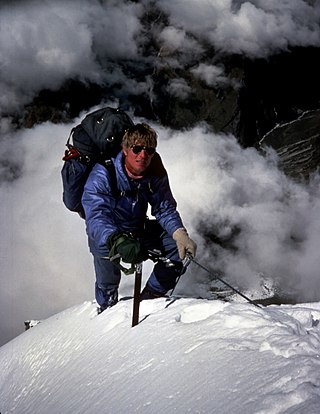
Scott Eugene Fischer was an American mountaineer and mountain guide. He was renowned for ascending the world's highest mountains without supplemental oxygen. Fischer and Wally Berg were the first Americans to summit Lhotse, the world's fourth highest peak. Fischer, Charley Mace, and Ed Viesturs summitted K2 without supplemental oxygen. Fischer first climbed Mount Everest in 1994 and later died during the 1996 blizzard on Everest while descending from the peak.
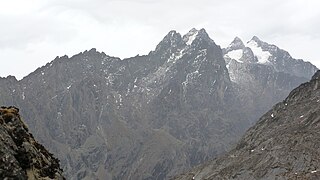
Mount Stanley or Mount Ngaliema is a mountain located in the Rwenzori range. With an elevation of 5,109 m (16,763 ft), it is the highest mountain of both the Democratic Republic of the Congo and Uganda, and the third highest in Africa, after Kilimanjaro (5,895 m) and Mount Kenya (5,199 m). The peak and several other surrounding peaks are high enough to support glaciers. Mount Stanley is named for the journalist and explorer Sir Henry Morton Stanley. It is part of the Rwenzori Mountains National Park, a UNESCO World Heritage Site.

Nyeri is a town situated in the Central Highlands of Kenya. It is the county headquarters of Nyeri County and was the central administrative headquarters of the country's former Central Province. Following the dissolution of the former provinces by Kenya's new constitution on 26 August 2010, the city is situated about 150 km north of Kenya's capital Nairobi, in the country's densely populated and fertile Central Highlands, lying between the eastern base of the Aberdare (Nyandarua) Range, which forms part of the eastern end of the Great Rift Valley, and the western slopes of Mount Kenya.
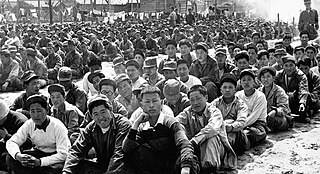
A prisoner-of-war camp is a site for the containment of enemy fighters captured as prisoners of war by a belligerent power in time of war.

Eric Earle Shipton, CBE, was an English Himalayan mountaineer.

Major Harold William Tilman, CBE, DSO, MC and Bar, was an English mountaineer and explorer, renowned for his Himalayan climbs and sailing voyages.

The Seven Second Summits are the second-highest mountains of each of the seven continents. All of these mountains are separate peaks rather than a sub-peak of the continents' high point. The Seven Second Summits are considered a harder challenge than the traditional Seven Summits.
Vivienne Florence Beatrice de Watteville was a British travel writer and adventurer, author of two books based on her experiences in East Africa in the 1920s, Out in the Blue (1927) and Speak to the Earth (1935). She is best remembered for taking charge of and continuing an expedition in the Congo and Uganda at the age of 24, when her father was killed by a lion.
Una May Cameron was a Scottish mountain climber known for her ascents in the Alps, Caucasus and Kenya.

Most of the peaks on Mount Kenya have been summited. The majority of these involve rock climbing as the easiest route, although some only require a scramble or a walk. The highest peak that can be ascended without climbing is Point Lenana, 4,985 metres (16,355 ft). The majority of the 15,000 visitors to the national park each year climb this peak. In contrast, approximately 200 people summit Nelion and 50 summit Batian, the two highest peaks.

Sergey Anatolyevich Kofanov is a Russian mountaineer.

Rick Ridgeway is an American mountaineer and adventurer, who during his career has also been an environmentalist, writer, filmmaker and businessman. Ridgeway has climbed new routes and explored little-known regions on six continents. He was part of the 1978 team that were the first Americans to summit K2, the world's second-highest mountain. From 2005 until he retired in 2020 he oversaw environmental affairs and public engagement at the outdoor clothing company Patagonia. He has authored seven books and dozens of magazine articles, and produced or directed many documentary films.

The Ascent is a 1994 American war adventure film directed by Donald Shebib. The film is an adaptation of a memoir by a then Italian prisoner of war in 1942 British East Africa who challenges his English captor in a climb of Mount Kenya.
















